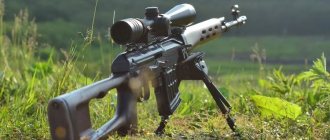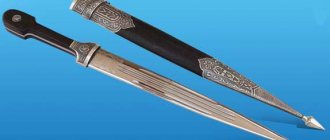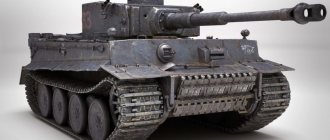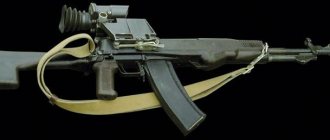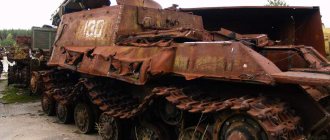Immediately at the entrance to the territory of the Congress and Exhibition Hall, an impressive “guard of honor” greets you with calm and confident power. The Armata tank, the T-15 infantry fighting vehicle, the Terminator tank support combat vehicle, and the 152-mm Coalition-SV artillery system were frozen in the ranks. This year, the Iron Guard has received new additions: the newest self-propelled artillery unit “Lotus”, self-propelled mortar “Drok” and armored car “Tiger-Atlet”.
The recruits do not hesitate - they are completely ready for battle.
Will penetrate any armor
“The Svinets-2 projectile is being demonstrated for the first time,” confirms Dmitry Maksimenko, a specialist at the Rostec Tekhmash concern. — This is a fundamentally new generation of ammunition.
A 125-mm 3VBM23 round with a 3BM60 armor-piercing sabot projectile penetrates any modern homogeneous armor. Even active dynamic protection will not save you from defeat. Tanks in service in the armies of all industrialized countries have armor of no more than 300 mm.
© Photo by the author
New high-power ammunition from the Tekhmash concern.
“Our new high-power ammunition “Svinets-2” penetrates 300 mm,” says Dmitry Maksimenko. “It has a core made of a special tungsten alloy and a unique new composition of gunpowder.
The projectile is primarily intended for firing at armored targets - tanks and self-propelled artillery units. However, the improved technical characteristics of the ammunition ensure the destruction of the entire range of military equipment of any potential enemy at a distance of more than two kilometers.
The use of this projectile requires equipping the tank with a new automatic loader. This is found on all Russian T-72, T-80 and T-90. For our tanks, which were previously exported to many countries around the world, specialists from the Tekhmash concern presented at the International Military-Technical Forum their other new development - the 125-mm Mango-M round. It penetrates 280 mm of armor, but does not require replacement of the automatic loader.
Foreign military attaches almost walked in formation at the Tekhmash exhibition stands on the first day of the arms forum. Indeed, there was something to see: the famous Tekhmash demonstrates almost 200 samples of highly effective ammunition.
© Vladimir Korobitsyn/zvezdaweekly.ru
Yuri Borisov, Deputy Prime Minister of the Russian Federation.
Direct speech
“The International Military-Technical Forum “Army” is one of the best world platforms for demonstrating the capabilities of modern weapons, where you can not just statically, but also dynamically look, touch, and verify the declared technical characteristics. Unique conditions have been created for negotiations, demonstration of equipment...
The anniversary forum demonstrates a lot of new products related to modern models of armored vehicles, modernized models of army aviation, a lot of new products dedicated to high-precision weapons, reconnaissance systems, electronic suppression, and robotics.”
Yuri Borisov, Deputy Prime Minister of the Russian Federation.
Friend core
The main way to dismantle a well-protected enemy vehicle is to hit it with an armor-piercing finned sabot projectile (BOPS). His “arrow” will simply pierce the armor. The main thing is to provide high kinetic energy due to the speed and mass of the core.
Speed comes from working on the explosives, the gun and the shape of the projectile. The mass of the core is a witchcraft over the material, and there are two main directions: tungsten or uranium alloys. Depleted uranium is used mainly by countries that have their own nuclear fuel cycle and do not particularly bother with ecology and humanism. The United States is in love with uranium and uses it without hesitation. The Bundeswehr prefers tungsten. Russia works with both materials, but tries not to shoot uranium outside special testing sites.
“Vacuum-2 will probably penetrate more than a meter of homogeneous armor”
American Love has a density of 19.05 g/cm3, which is 2.5 times greater than that of steel, correspondingly heavier, due to which greater kinetic flight energy is achieved. In addition, due to the low thermal conductivity of uranium, the core undergoes adiabatic wear upon impact with the armor. You could say it sharpens itself. A sharp arrow will always pierce better than a dull one, like an old hammer. After penetrating the armor, uranium dust, due to its pyrophoric properties, penetrates the tank and flares up, providing good armor penetration. And depleted uranium is formally free, because it is waste. In fact, organizing work with it is not at all cheap, because not only is it radioactive, it is also quite poisonous.
Tungsten is denser - 19.25 g/cm3 (by 1%). It also has a super property - a high melting point, 2.6 times higher than that of uranium. Therefore, in conditions when a radioactive “crowbar” begins to flow due to colossal temperatures (if any occur) at the point of impact, the tungsten one retains its hardness. All other things being equal, tungsten BOPS loses to uranium, but at a flight speed of about two kilometers per second it begins to take its toll. By the way, the new 2A82 gun spits out BOPS at such speeds. The disadvantage of tungsten is its cost. Advantages - it is somewhat easier to work with and it is more humane to use.
MTU-2020 will solve the problem of the assault bridge in 2-3 minutes
About 1,300 enterprises are participating in the International Military-Technical Forum "Army-2019". They present more than 2,700 exhibits. The Russian Ministry of Defense shows 361 units of weapons, military and special equipment from its “ammunition load”. There are also new products that are being shown for the first time.
“Imagine the situation: our tanks are advancing, and suddenly there is a ravine or river on the way that they cannot overcome straight away,” says Lieutenant Colonel Oleg Gurishkin at the demonstration site of the Russian engineering troops. — MTU-2020 will solve the problem in 2-3 minutes.
© Photo by the author
The newest tank bridge layer MTU-2020.
MTU-2020 is the latest tank bridge laying vehicle. It was created by the designers of Omsktransmash (part of the Uralvagonzavod corporation) specifically for the installation of assault bridges during modern combined arms combat. The bridge layer is made on the basis of the T-90MS battle tank (only one roller was added to perform a special task). The crew - the commander (also known as the operator) and the driver - are reliably protected by armor. All work is carried out directly from the combat vehicle, information from several surveillance cameras and sensors is fed to the display.
“The main know-how of MTU is the bridge structure made from the latest domestic composite materials and a competent engineering solution for distributing the load along the axes,” continues Lieutenant Colonel Oleg Gurishkin. — Previous generations of bridgelayers used bridges made of steel or aluminum. They did not exceed 24 meters. The new MTU allows you to give way in battle through obstacles 27 meters long.
The design can withstand the weight of military equipment up to 60 tons. The heavy Armata, for example, weighs 55-56 tons. That is, all our tanks and wheeled missile systems will pass through.
According to the officer, after being shown at the forum, MTU-2020 will immediately go for final tests at the Research Institute of Engineering Troops, after which the new product will be recommended for acceptance for supply.
Two "Leads"
When creating the Svinets BOPS in the late 80s, the designers squeezed the maximum out of the automatic loader and used every millimeter. The length of the active part was 635 millimeters. The monolithic core was made of tungsten carbide, a sub-caliber empennage was added, more powerful gunpowder was added, and the result was penetration from two kilometers along the normal of 650 millimeters and 320 at an angle of 60 degrees. Very good for its time.
On this basis, two new BOPS systems were created in modern Russia.
“Lead-1” with a tungsten core penetrates 700–740 millimeters of homogeneous steel. “Svinets-2,” whose core is made of a tungsten-uranium alloy with the romantic name “Material B,” pierces a slab of 800–830 millimeters. This is enough to, with a good shot in the forehead, pick apart the hull of any tank and confidently pierce the turret in vulnerable places.
Any Russian tank of the latest modifications can use the “Lead” series shells: T-72B3, T-80BVM, T-90A, and, if desired, the T-14.
But for now there is nothing to use - the Ministry of Defense is purchasing Lekalo. Let's hope it's temporary.
If “Lead” corresponds to the stated characteristics, then this is, perhaps, the most powerful mass-produced BOPS that will shine for our army while the T-72BZ forms the basis of its armored forces, and therefore for the coming decades. And the only one that allows the T-72B3 to survive a meeting with a NATO tank.
No one will have such a strong “castle” in the sky
The timing of serial deliveries to the Russian Armed Forces of the newest S-500 air defense system, which has no analogues in the world, has been shifted: it will go into service with the troops soon. Deputy Prime Minister of the Russian Government Yuri Borisov announced this at the IWTF-2019.
“Successful preliminary tests allowed the Russian Ministry of Defense to make a decision to reduce the time frame for the start of serial deliveries of this anti-aircraft missile system to the troops,” he said. “As a result, S-500 systems will begin to arrive in anti-aircraft missile regiments in the coming years. Now phased tests of various elements of the S-500 are being carried out with launches of new missiles.
Azerbaijani "Predator" and Belarusian "counter-battery"
In addition, the sites and pavilions of the International Military-Technical Forum are also a clear propaganda of how all the “sanctions wars” announced to us have failed. Here you can study the styles of military uniforms of military personnel from dozens of countries around the world.
In 2022, politicians, generals, diplomats and military specialists from 120 countries are participating in the Russian weapons forum. In addition to the Russian one, in the Congress and Exhibition Center near Moscow, 10 more national expositions are presented. China, Pakistan, Turkey, Azerbaijan, Thailand, South Africa, Armenia, Belarus, India and Kazakhstan demonstrate examples of their weapons and military and dual-use technologies.
© Photo by the author
Advisor to the Minister of Defense Industry of the Republic of Azerbaijan Azad Mamedov and the Predator sniper rifle.
“Our republic presented an exposition for the first time at a forum in Russia,” Azad Mamedov, adviser to the Minister of Defense Industry of the Republic of Azerbaijan, told the weekly Zvezda . “I would like to immediately say a big thank you to the organizers of the exhibition - the Russian military. We were warmly welcomed and all conditions for work were created; the organization of the forum was excellent.
Gunsmiths from the shores of the Caspian Sea presented samples of small arms and ammunition at Army-2019. Machine guns and machine guns are basically modernization of Kalashnikovs to perform special tasks. But there are also our own developments on the stands of the national exhibition. For example, the new Predator sniper rifle. This semi-automatic rifle is chambered for 7.62x54 cartridge.
The Belarusian defense industry traditionally exhibits high-tech complexes in Russia. This year, the attention of specialists was attracted, for example, by the AN/TPQ-60-RT counter-battery radar. Its purpose is to conduct reconnaissance of visually unobservable firing positions of enemy mortars, artillery, and rocket systems along the flight path of ammunition at a range of 0.5 to 25 km. The radar is air transportable, easy to operate, deployment time is 5 minutes.
“Of course, we hope that our development will be of interest to the Russian military and their colleagues from other countries,” says Vadim Tereshchenko, deputy director of the REATECHNO scientific and technical enterprise. — Russian Defense Minister Sergei Shoigu drew attention to this radar during his visit to the Belarusian national exposition. We understand that you already have similar counter-battery weapons, but we believe that our products have good export potential within the Union State and the CSTO.
© Vladimir Korobitsyn/zvezdaweekly.ru
Minister of Defense of the Russian Federation, Army General Sergei Shoigu.
Direct speech
“Contrary to the sanctions that were introduced to slow down, among other things, scientific and technological progress in Russia, defense industry enterprises not only survived, but are also increasing the positive dynamics of development.”
Sergei Shoigu, Minister of Defense of the Russian Federation, Army General.
"Pattern" for NATO
This BOPS was put into service back in the late 90s, but production somehow didn’t work out. Tungsten core, armor penetration - 650 millimeters in a straight line and about 320 at an angle of 60 degrees.
This allows, with an ideal shot from two kilometers, to penetrate the hull armor of most tanks of modifications of the 90s and 2000s. If you get closer and aim at the vulnerable spots of the tower, you will be able to hit it too.
But, for example, the Abrams M1A2SEP can only be hit with a “pattern” at the side projection, but at least at the hull, at least at the turret, and from any angle.
This year, the Ministry of Defense ordered two thousand such BOPS for the army. This is half the ammunition capacity of hundreds of tanks. Better than Mango, of course, but still not enough.
"Hunter" is still in "ambush"
The first thing many experts and journalists did was look for the latest Russian drone “Okhotnik” at the arms forum in the Moscow region. Alas for us!
A promising unmanned aerial vehicle, which, according to quiet hints from news agency sources in the Russian military-industrial complex, should surpass foreign analogues in all qualities, was presented at the IMF-2019 only in the form of a reduced model.
Obviously, this UAV, which is currently being tested, does not need to be shown to competitors yet. Well, let's wait until Army 2020.
Iron athleticism: not even two kilograms of TNT
This combat vehicle has an extremely serious appearance. I immediately remember the saying that giving way to a tank is not out of politeness. The new “Tiger”, developed by scientists and designers of the Military-Industrial Institute, is, of course, not a tank, but an armored car, but the new one has solid armor.
“This is our new car, developed as part of the Atlet development work,” managing director of the Military Engineering Yuri Korolev told the Zvezda weekly, “240 horsepower, the maximum speed of a nine-ton armored car is at least 120 kilometers per hour, cruising range — 1,000 kilometers. The level of protection is second class, the armor protects the crew and troops in the compartment.
© Photo by the author
Armored car "Tiger-Atlet".
According to Yuri Nikolayevich, taking into account the experience of combat use of armored vehicles gained in various “hot spots”, the newest “Tiger” has significantly improved mine resistance. It can withstand explosions of ammunition up to two kilograms in TNT equivalent not only under the bottom, but also under each wheel.
The new vehicle can be equipped with various weapons. For example, remotely controlled combat modules. In all its tactical and technical characteristics, the Russian armored vehicle "Tiger-Atlet" is not inferior, and in some ways superior to the best foreign analogues.
According to VPK General Director Alexander Krasovitsky, in total the company has delivered more than 1,500 Tigers of various modifications to customers. Obviously, no problems are expected with the further growth of the “population” of this “predator” of the battlefield.
© Photo by the author
The best military equipment at the Army 2019 forum.
Direct speech
“Army 2019 is an opportunity to simultaneously see all the best military equipment, which is presented by more than 250 of the largest companies in the defense-industrial complex of our country. Here are promising samples that are at the last stage of testing and will soon enter service.”
Denis Manturov, Minister of Industry and Trade of the Russian Federation.
"Mango-Mango"
The main Russian BOPS is Mango, developed in the mid-80s. His example shows that this is not just scrap metal. The ballistic cap hides an armor-piercing cap, behind it is a damper, which allows you to get a good “bite” when hit at an angle, and only then are two cores made of a tungsten-nickel-iron alloy placed in series. Their total length is 420 millimeters, and their thickness is only 18 millimeters, the size of the active part of the entire BOPS is 574 millimeters. The whole thing is crowned with a caliber stabilizing tail and 3.4 kilograms of additional charge.
Photo: regnum.ru
Photo: regnum.ru When fired from two kilometers, the Mango, when hit at point-blank range, penetrates 450 millimeters of homogeneous armor steel, and at an angle of 60 degrees – 230 millimeters. It was this BOPS that was often included with Russian tanks when delivered abroad. And recently Tekhmash presented a modernized version of Mango-M with an eye to export. The length of the active part has increased to 610 millimeters. The new projectile penetrates 560 millimeters of steel in the forehead, and 280 at an angle of 60 degrees.
Owners of Russian tanks of older modifications do not have many options, so the new BOPS will, of course, interest them.
The new Mango will pierce the side of the Abrams hull at any angle, as long as it doesn’t ricochet. But in order to break through the side of the tower, you will have to fit into 45 degrees. The same is true for other NATO tanks and indeed for any tanks. It's just that the angles at which the tower hits will be different.
We are not talking about hitting it in the forehead.
Records - to be
As the weekly Zvezda was told in the Department of Information and Mass Communications of the Ministry of Defense of the Russian Federation, in terms of key indicators, the International Military-Technical Forum “Army”, held since 2015, breaks its own records from year to year - in terms of exhibition area, in the number of exhibited equipment, by the number of participants and spectators.
The Russian IMF confidently competes with the leading military-technical exhibitions of the world; it has gained a reputation as an effective and reliable platform for constructive dialogue between military experts, representatives of science and enterprises of the defense-industrial complexes of various states.
